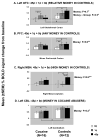Is decreased prefrontal cortical sensitivity to monetary reward associated with impaired motivation and self-control in cocaine addiction?
- PMID: 17202543
- PMCID: PMC2435056
- DOI: 10.1176/ajp.2007.164.1.43
Is decreased prefrontal cortical sensitivity to monetary reward associated with impaired motivation and self-control in cocaine addiction?
Abstract
Objective: This study attempted to examine the brain's sensitivity to monetary rewards of different magnitudes in cocaine abusers and to study its association with motivation and self-control.
Method: Sixteen cocaine abusers and 13 matched healthy comparison subjects performed a forced-choice task under three monetary value conditions while brain activation was measured with functional magnetic resonance imaging. Objective measures of state motivation were assessed by reaction time and accuracy, and subjective measures were assessed by self-reports of task engagement. Measures of trait motivation and self-control were assessed with the Multidimensional Personality Questionnaire.
Results: The cocaine abusers demonstrated an overall reduced regional brain responsivity to differences between the monetary value conditions. Also, in comparison subjects but not in cocaine abusers, reward-induced improvements in performance were associated with self-reports of task engagement, and money-induced activations in the lateral prefrontal cortex were associated with parallel activations in the orbitofrontal cortex. For cocaine abusers, prefrontal cortex sensitivity to money was instead associated with motivation and self-control.
Conclusions: These findings suggest that in cocaine addiction 1) activation of the corticolimbic reward circuit to gradations of money is altered; 2) the lack of a correlation between objective and subjective measures of state motivation may be indicative of disrupted perception of motivational drive, which could contribute to impairments in self-control; and 3) the lateral prefrontal cortex modulates trait motivation and deficits in self-control, and a possible underlying mechanism may encompass a breakdown in prefrontal-orbitofrontal cortical communication.
Figures



Comment in
-
To do or not to do? The complexities of addiction, motivation, self-control, and impulsivity.Am J Psychiatry. 2007 Jan;164(1):4-6. doi: 10.1176/ajp.2007.164.1.4. Am J Psychiatry. 2007. PMID: 17202534 No abstract available.
References
-
- Rollnick S, Heather N, Bell A. Negotiating behaviour change in medical settings: the development of brief Motivational Interviewing. Journal of Mental Health. 1992;1:25–37.
-
- Garavan H, Pankiewicz J, Bloom A, Cho JK, Sperry L, Ross TJ, Salmeron BJ, Risinger R, Kelley D, Stein EA. Cue-induced cocaine craving: neuroanatomical specificity for drug users and drug stimuli. Am J Psychiatry. 2000;157(11):1789–98. - PubMed
-
- Kalivas PW, Volkow ND. The neural basis of addiction: a pathology of motivation and choice. Am J Psychiatry. 2005;162(8):1403–13. - PubMed
Publication types
MeSH terms
Substances
Grants and funding
- R01 DA006891/DA/NIDA NIH HHS/United States
- K23 DA015517/DA/NIDA NIH HHS/United States
- R03 DA017070/DA/NIDA NIH HHS/United States
- M01 RR010710/RR/NCRR NIH HHS/United States
- 5-M01-RR-10710/RR/NCRR NIH HHS/United States
- AA/OD09481-04/AA/NIAAA NIH HHS/United States
- K24-DA-16170/DA/NIDA NIH HHS/United States
- 1K23-DA-15517-01/DA/NIDA NIH HHS/United States
- R03-DA-017070-01/DA/NIDA NIH HHS/United States
- DA-06891-06/DA/NIDA NIH HHS/United States
- R01 AA009481/AA/NIAAA NIH HHS/United States
- K02-DA-16991/DA/NIDA NIH HHS/United States
LinkOut - more resources
Full Text Sources
Medical

